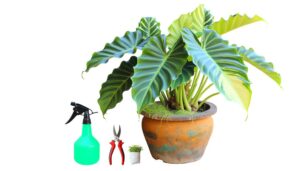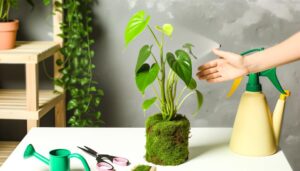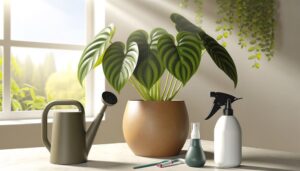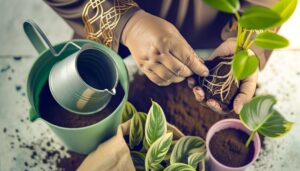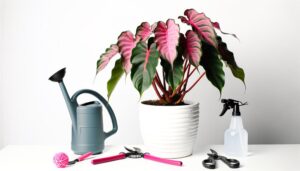How Do I Care for a Philodendron Birkin? Step-by-Step Guide!
Philodendron Birkin, a popular houseplant with variegated foliage, needs bright, indirect sunlight and thrives in humid conditions with 50-60% humidity. Water when the top inch of the moisture-retentive, well-draining soil mix becomes dry.
Choose a blend of peat, perlite, and orchid bark for the soil to support root development. Regular pruning and pest monitoring are key to maintaining plant health.
Readjust care with season changes and the plant’s densification levels. Digging further into the plant’s needs, including troubleshooting for common issues and repotting, will enhance your care strategy, ensuring your Philodendron Birkin flourishes beautifully.
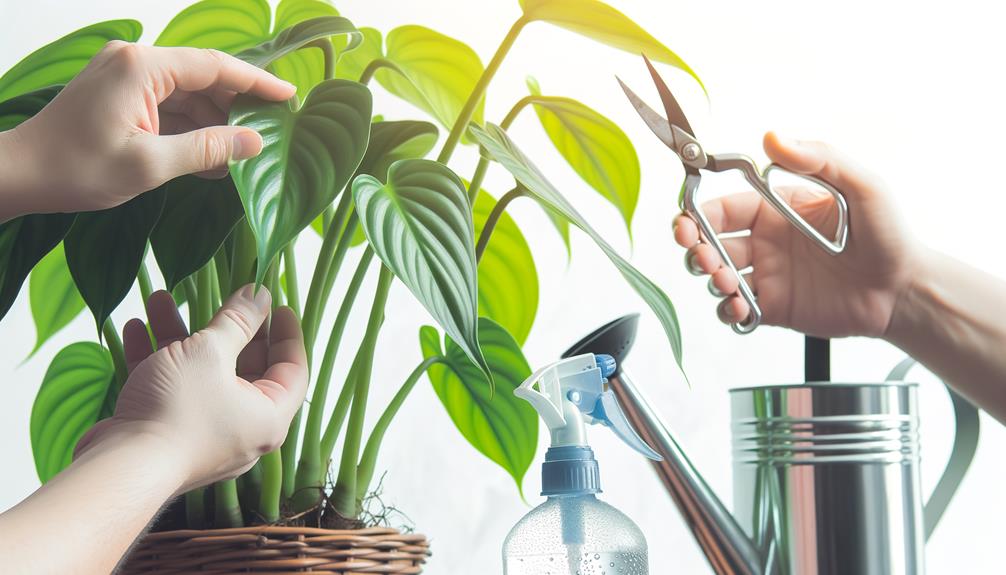
Key Takeaways
- Position your Philodendron Birkin in bright, indirect sunlight, ideally near a north or east-facing window.
- Water the plant thoroughly, letting the top inch of soil dry out before the next watering.
- Maintain humidity levels between 50-60% by misting or using a humidifier.
- Use a well-draining, moisture-retaining soil mix, like a blend of peat, perlite, and orchid bark.
- Regularly prune yellow or brown leaves and monitor for pests, treating with natural insecticidal soap if necessary.
Understanding the Philodendron Birkin
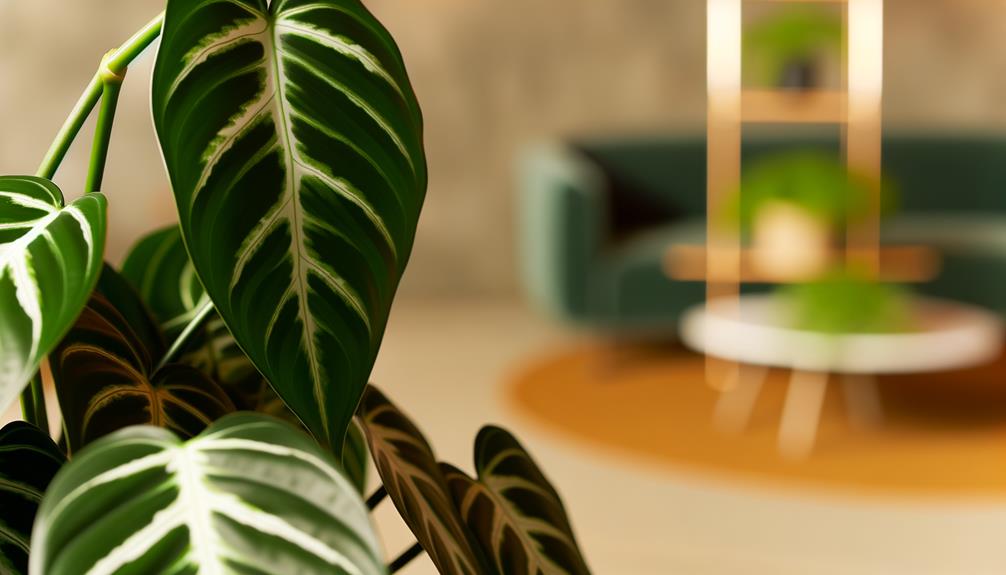
What exactly is a Philodendron Birkin, you might ask?
This unique plant species is a part of the large Philodendron genus and is renowned for its striking variegated foliage, with white pinstripes on dark green leaves. Originating from the rainforests of South America, it is a tropical perennial plant that thrives in warm, humid environments. Its characteristic pinstripes give it an aesthetic appeal making it a popular choice for interior spaces.
As it grows, the pattern becomes more pronounced, enhancing its visual interest. A mature Philodendron Birkin can reach up to 3 feet in height, making it a compact yet impactful choice for both personal and commercial spaces. Understanding its nature and growth habits is essential for its effective care and maintenance.
Ideal Lighting Conditions
Shedding light on the preferred conditions, a Philodendron Birkin thrives in bright, indirect sunlight which mirrors its natural rainforest habitat. This species can adapt to lower light levels but may exhibit stunted growth or variegation loss.
The ideal position is near a north or east-facing window, where it will receive consistent but diffused light. Avoid direct sunlight, as it can scorch the leaves, leading to permanent plant damage. Artificial light sources, such as fluorescent lamps, can supplement natural light, especially in darker interiors.
Monitor light exposure regularly, adjusting the plant’s placement as necessary to ensure prime photosynthesis. Understanding these lighting conditions can greatly enhance the health and aesthetic appeal of your Philodendron Birkin, contributing to a nurturing environment.
Watering Your Plant Correctly
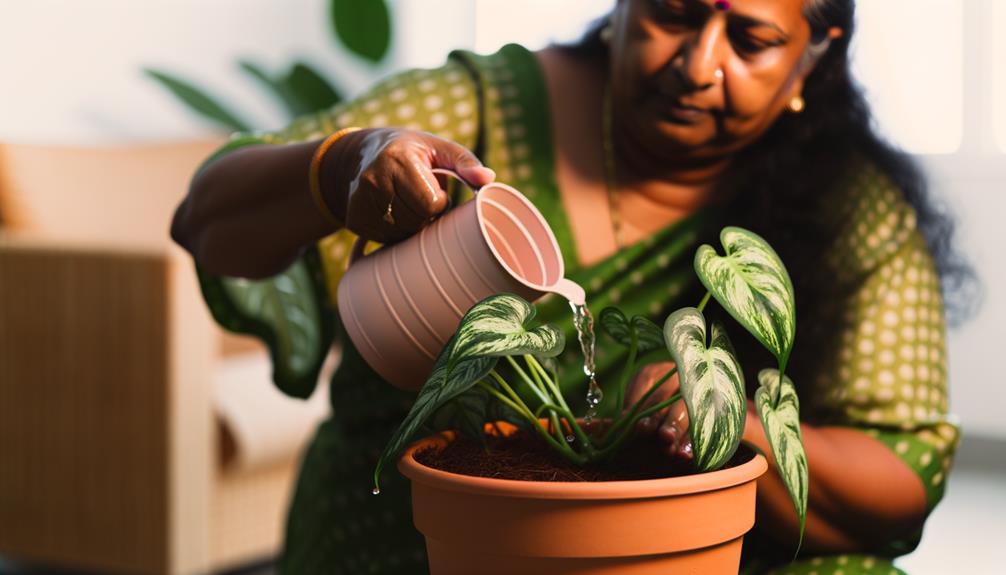
As we shift from lighting to hydration, we need to approach the crucial aspect of watering the Philodendron Birkin correctly. Our primary focus will be on establishing the best watering techniques that support the plant’s health and importance.
We will also address strategies to prevent the common issue of overwatering damage, which can harmfully impact the plant’s growth and overall wellbeing.
Optimal Watering Techniques
The Philodendron Birkin’s hydration requirements, like many tropical plants, are directly influenced by the humidity and temperature of its surroundings, necessitating a careful and knowledgeable approach to watering.
The ideal watering method involves thoroughly saturating the potting mix until water drains from the bottom. This replicates the natural rainfall these plants would receive in their native environments. Then, allow the top inch or two of soil to dry out before watering again, as this prevents waterlogging and promotes root health.
Regularly check the plant’s moisture levels using a moisture meter or by manually feeling the soil. It is worth mentioning that the Philodendron Birkin prefers a slightly moist but well-drained soil condition.
Adjust your watering frequency based on the season, as the plant’s water requirements will decrease during cooler months.
Preventing Overwatering Damage
To protect your Philodendron Birkin from the harmful effects of overwatering, it is vital to comprehend and implement proper watering techniques that prevent waterlogging and root rot.
The first step is to evaluate the moisture level of the soil: if the top inch is dry, it’s time to water; if not, wait. Overwatering leads to root suffocation and decay, impeding nutrient absorption.
Use well-draining soil and make sure your pot has adequate drainage holes. When watering, do so evenly until water seeps out the drainage holes, then allow the excess to drain. Never let the plant sit in standing water.
Monitor your plant’s health regularly, adjusting watering schedules based on season, temperature, and humidity levels. Proper hydration is essential for a thriving Philodendron Birkin.
Importance of Humidity Levels
Understanding the appropriate humidity levels is crucial for the healthy growth and development of a Philodendron Birkin. This tropical plant thrives in a humid environment, reflecting its native rainforest habitat. Humidity levels between 50% and 60% are ideal.
Lower humidity can result in leaf curling or browning at the edges, indicators of dehydration. To maintain these levels, regular misting, pebble trays filled with water, or a room humidifier can be used.
It’s important to monitor humidity regularly, especially in arid climates or during winter months when indoor heating can significantly reduce humidity levels. Insufficient humidity levels can cause stress to the plant, hindering its growth, and making it more vulnerable to pests and diseases.
Proper humidity management, in turn, plays a vital role in a healthy, vibrant Philodendron Birkin.
Choosing the Right Soil
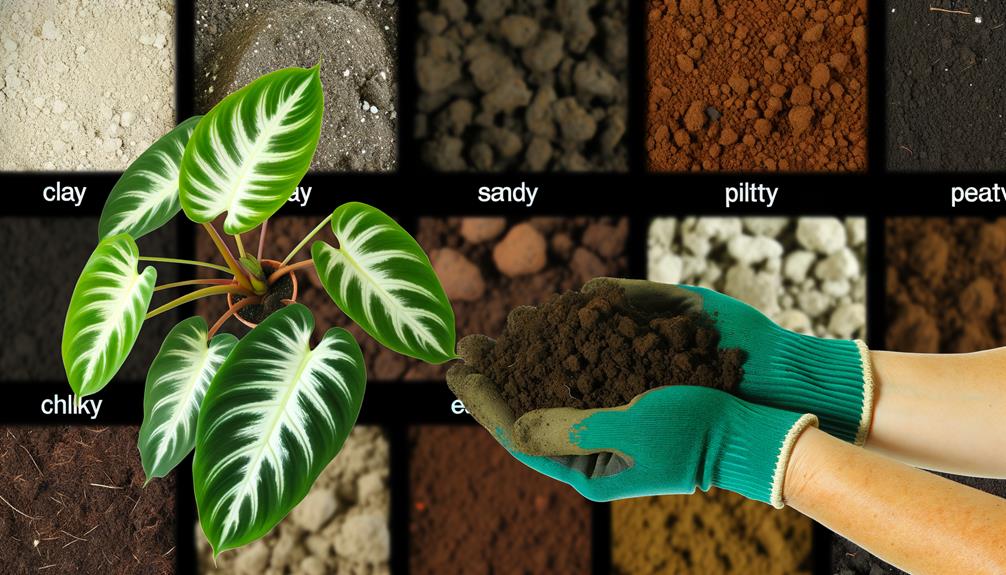
In the world of Philodendron Birkin care, selecting a suitable soil mix is essential to guarantee peak growth and health. The ideal mix should be well-draining yet moisture-retentive. A blend of peat, perlite, and orchid bark is recommended. This combination provides the right balance of moisture retention, drainage, and aeration that Philodendron Birkin requires.
| Soil Component | Function | Percentage |
|---|---|---|
| Peat | Retains moisture | 50% |
| Perlite | Provides drainage | 25% |
| Orchid Bark | Enhances aeration | 25% |
Always remember, a well-chosen soil mix can greatly contribute to the overall well-being of your Philodendron Birkin. The right soil not only supports root development but also aids in nutrient uptake, contributing to a healthier, more vibrant plant.
Fertilizing Your Philodendron Birkin
The subsequent pivotal step in ensuring the health and longevity of your Philodendron Birkin is the application of suitable fertilizers using correct techniques.
A thorough understanding of the best type and composition of fertilizers for this particular species is essential to its growth and development.
Equally important is the mastery of appropriate fertilizing methods, which can greatly impact the plant’s overall vigor and resilience.
Choosing the Right Fertilizer
Choosing the right fertilizer for your Philodendron Birkin necessitates thorough understanding of nutrient composition to achieve peak plant health and growth.
Fertilizers are typically classified by their ratio of Nitrogen (N), Phosphorus (P), and Potassium (K), the three primary macronutrients essential to plant growth. A balanced N-P-K fertilizer, such as a 20-20-20, provides equal parts of each nutrient, and is generally suitable for Philodendron Birkin.
However, during the growing season, a higher nitrogen concentration can encourage foliage development. In contrast, during the dormant winter period, a lower nitrogen mix is recommended.
Always choose a reputable brand of fertilizer for quality assurance. Remember, the right fertilizer can greatly enhance the vibrancy and health of your Philodendron Birkin.
Proper Fertilizing Techniques
To guarantee the best health and growth of your Philodendron Birkin, it is essential to adopt proper fertilizing techniques. A balanced liquid fertilizer diluted to half-strength is generally recommended, applied once a month during the growing season (spring to early fall).
Avoid over-fertilizing as it can lead to salt build-up in the soil, which can damage the plant’s roots. Ensure the plant is watered thoroughly before and after applying the fertilizer to prevent root burn.
If you notice yellow leaves or stunted growth, it may be a sign of nutrient deficiency. In such cases, the application frequency may need to be increased. Conversely, if the leaves become brown or curl at the edges, it may indicate over-fertilization.
Monitor your plant’s health closely and adjust fertilizing practices accordingly.
Pruning and Maintenance Tips
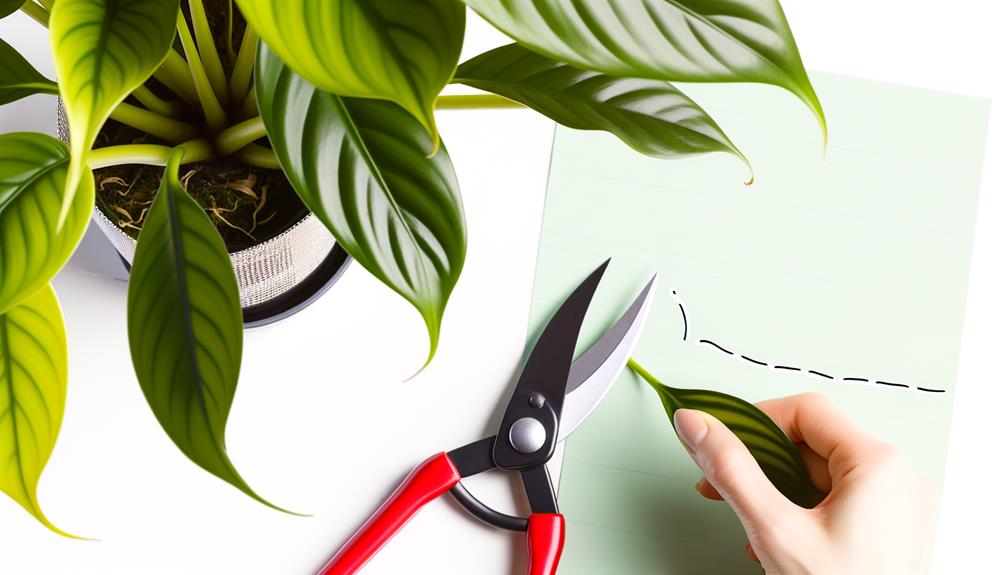
Proper pruning and consistent maintenance are essential elements in fostering the vibrant growth and health of a Philodendron Birkin.
Here are three key tips to promote effective pruning and maintenance:
- Prune Regularly: Remove yellow or brown leaves as they appear to prevent disease spread and enhance overall plant health. This encourages healthier growth and visual appeal.
- Use Clean Tools: Always use sterilized pruning equipment to prevent the spread of diseases. Clean your shears with rubbing alcohol before and after each use.
- Monitor Growth: Regularly examine your plant for signs of excessive growth. If it becomes too dense, thin out some foliage to allow light to reach all parts of the plant.
These straightforward yet impactful steps will help foster your Philodendron Birkin remains healthy and vibrant, serving as a focal point for any room.
Dealing With Common Pests
Philodendron Birkin, like any plant species, is susceptible to a range of common pests that can be harmful to its health and aesthetic appeal.
To effectively manage this issue, it is important to accurately identify the pest species, apply the appropriate pesticide solutions, and implement preventive measures to reduce future infestations.
This discussion will explore these three key aspects in detail, providing a thorough approach to pest management for your Philodendron Birkin.
Identifying Common Pests
In the domain of indoor horticulture, a Philodendron Birkin may encounter several types of pests that pose a threat to its health, such as spider mites, aphids, and mealybugs.
- Spider Mites: These tiny pests are often unseen by the naked eye but can be identified by the delicate, silken webbing they leave on the undersides of leaves.
- Aphids: Small, pear-shaped insects that feed on plant sap. Signs of their presence include curled, yellowing leaves and a sticky substance known as honeydew.
- Mealybugs: These pests appear as white, cottony masses on plant stems and leaves. They also feed on plant sap, causing leaves to yellow and drop prematurely.
Understanding these pests is essential in ensuring the sustained health of your Philodendron Birkin.
Effective Pesticide Solutions
Often, the most effective method to combat common pests in a Philodendron Birkin is through the use of targeted pesticide solutions, each uniquely designed to eradicate specific types of insects.
For instance, insecticidal soaps are proven to be effective against soft-bodied pests like aphids, thrips, and mealybugs, disrupting their cell membranes and causing dehydration.
Alternatively, a more specialized pesticide like Spinosad can be used to deal with caterpillars and leaf miners, working by activating the insect’s nervous system.
For scale insects and spider mites, a horticultural oil or neem oil can be utilized, suffocating the pests by clogging their airways.
It is important to apply these treatments judiciously, ensuring thorough coverage while mitigating potential harm to non-target organisms.
Preventive Pest Measures
To safeguard your Philodendron Birkin from the threat of common pests, implementing preventive measures can prove to be an effective strategy.
A systematic and consistent approach is essential, encompassing the following aspects:
- Regular Inspection: Monitor the foliage and stems periodically for the presence of pests. Early detection can prevent infestations from escalating.
- Adequate Spacing: Maintain enough space between your plants to prevent the spread of pests.
- Proper Hygiene: Regularly clean the plant and its surroundings. Remove dead leaves promptly as they can attract pests.
These measures, when diligently applied, can notably reduce the risk of pest attacks. Providing a safe and healthy environment for your Philodendron Birkin not only maintains its vitality but also enhances the aesthetic appeal of your living space.
Repotting Your Philodendron Birkin
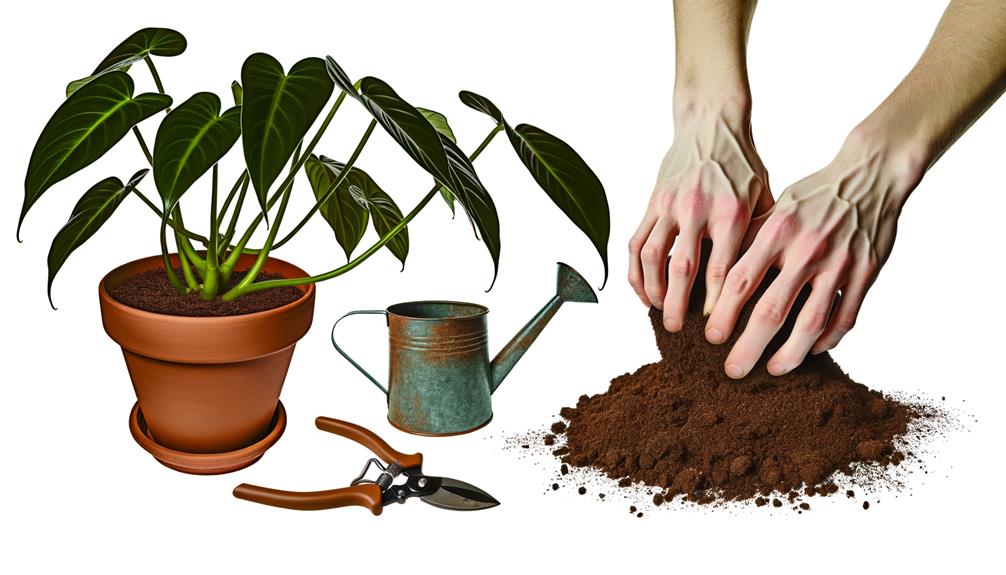
When your Philodendron Birkin has outgrown its current pot, a careful repotting process becomes essential for the plant’s continued healthy growth. You should endeavor to repot at the onset of the growing season, typically in the spring, when the plant is most resilient.
Choose a new pot that is 1-2 inches larger in diameter than the current one to allow room for expansion. Utilize a well-draining, peat-based potting mix to encourage root health. Gently remove the plant from its current pot, taking care not to damage the delicate root system. Place it in the new pot, filling in around the roots with fresh potting mix.
After repotting, thoroughly water the plant and place it in a well-lit, but not direct sunlight, location to recover.
Troubleshooting Common Issues
Despite meticulous attention, Philodendron Birkin may occasionally encounter common issues such as yellowing leaves, slow development, or pest infestations, which require effective troubleshooting strategies.
- Yellowing Leaves: This could be due to overwatering or lack of nutrients. Adjust watering schedules and consider a balanced, slow-release fertilizer to counteract this problem.
- Slow Growth: Too little light or inadequate temperature can impact growth speed. Ensure the plant is receiving indirect, bright light and the room temperature remains between 60°F and 75°F.
- Pest Infestations: Mealybugs, spider mites, or aphids might attack your plant. Regularly inspect the leaves and stem. If pests are detected, a natural insecticidal soap can be a safe, effective solution.
Lemon Lime Heartleaf Philodendron Care
The Lemon Lime Heartleaf Philodendron (Philodendron hederaceum ‘Lemon Lime’) is a vibrant, low-maintenance houseplant. Here are some care tips:
- Light: Prefers bright, indirect light but can tolerate low light. Avoid direct sunlight, which can scorch the leaves.
- Water: Water when the top inch of soil feels dry. Ensure the pot has drainage holes to prevent waterlogging.
- Humidity: Thrives in moderate to high humidity. If the air is too dry, consider misting the leaves occasionally.
- Temperature: Ideal temperature range is 65-80°F (18-27°C). Protect from drafts and cold temperatures below 55°F (13°C).
- Soil: Use a well-draining potting mix. A mix designed for aroids or general houseplants works well.
- Fertilizer: Feed monthly during the growing season (spring and summer) with a balanced, water-soluble fertilizer diluted to half strength.
- Pruning: Prune to control growth and shape. Cut just above a leaf node to encourage bushier growth.
- Pests: Watch for pests like spider mites, mealybugs, and aphids. Treat with insecticidal soap or neem oil if necessary.
With proper care, the Lemon Lime Heartleaf Philodendron will thrive, showcasing its bright, chartreuse foliage.
Conclusion
To wrap up, the Philodendron Birkin is a plant that thrives in specific conditions. Through careful monitoring of lighting, watering, humidity, soil choice, pruning, pest control, and repotting, one can cultivate a healthy and vigorous plant.
Just like nurturing a piece of art, maintaining this exotic plant requires patience, precision, and understanding. This rewarding process can lead to a fascinating indoor botanical display, reflecting the wonders and intricacies of nature.

